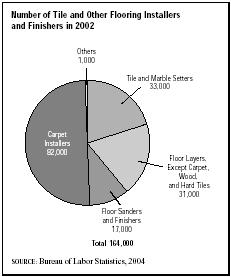SIC 1743
TERRAZZO, TILE, MARBLE, AND MOSAIC WORK
This category covers special trade contractors that primarily set and install ceramic tile, marble, and mosaic, and those that mix marble particles and cement to make

terrazzo at construction sites. Companies that primarily make pre-cast terrazzo steps, benches, and other terrazzo objects are in SIC 3272: Concrete Products, Except Block and Brick.
NAICS Code(s)
235420 (Drywall, Plastering, Acoustical and Insulation Contractors)
235430 (Tile, Marble, Terrazzo and Mosaic Contractors)
Terrazzo, tiles, marble, and mosaic have been used in construction for centuries, lending charm and elegance to houses, churches, and public buildings. This respected craft requires skill but offers the opportunity for artistic expression, particularly in the use of terrazzo and mosaic materials.
The U.S. Department of Labor reported that approximately 33,000 tilesetters were employed in 2002. Those who were employed by contractors tended to be assigned to nonresidential construction projects. Almost half were self-employed and worked primarily on residential projects. During the early 2000s, the industry included many companies that served customers locally, although some firms covered broader areas.
Much of the marble and other material used in this industry is imported from countries such as Italy. In fact, imports from Italy account for nearly 27 percent of U.S. domestic tile consumption. Terrazzo originated hundreds of years ago when Venetian craftsmen discovered a new use for discarded marble chips. Terrazzo is made by mixing pebbles or chips of stone or glass in cement, then polishing the surface to make it smooth. Terrazzo is one of the most durable flooring surfaces, and it can also have aesthetic qualities.
Tiles traditionally are square pieces of fired clay used to cover exterior or interior surfaces such as floors, walls, or roofs. Craftsmen in this trade also use thin slabs of vinyl, wood, cork, and other materials in a similar way. Most civilizations since 3000 B.C. have used ceramic tiles, often for decorative purposes. Because they are durable and easy to clean, tiles are commonly used in areas such as bathrooms, swimming pools, and medical operating rooms.
Marble is a metamorphic rock often with irregular markings from impurities, which add to its appeal and beauty. It has been used in many architectural landmarks including the Parthenon and the Taj Mahal.
Mosaic is a decorative surface made by setting small colored pieces, such as tile, in mortar or other adhesive. Employed in architecture since 3000 B.C., mosaic is still used in places where a waterproof, hygienic surface is required, especially if decoration is also desired.
Although this industry is based on a craft that is centuries old, some new methods have been developed to make the work easier or less expensive. In contrast to the traditional methods of setting and polishing terrazzo or laying out tile and mosaic at the construction site, some manufacturers began selling prefabricated materials. Other innovations included vinyl tile designed to look like natural formations, as well as new lightweight panels and bonding materials that made tile more suitable for exterior surfaces, even on high-rise buildings.
After experiencing sluggish sales in 2001, U.S. tile factories produced a record 638 million square feet of tile in 2002. Domestic factory revenues climbed 8 percent. Factory shipments, including imports, grew 15.7 percent to 2.63 billion square feet. According to the Tile Council of America, factory shipments will grow to 2.71 billion square feet in 2004. This growth was fueled by brisk sales in the residential construction market, which saw new housing starts reach a 25-year high in 2003. Larger-sized glazed tile accounted for roughly 90 percent of total ceramic tile sales in the United States.
Exports, which were primarily to Canada and Mexico, increased by 25.2 percent to 41.7 million square feet in 2002. The United States ranks ninth among the leading tile exporters in the world. Imports increased by 18.5 percent. The United States is the world's largest importer of tile, based on square footage. After Italy, the leading exporters to the United States are Spain and Mexico.
Several trade associations serve contractors and manufacturers in this industry. They include the National Terrazzo and Mosaic Association, the Ceramic Tile Institute of America, the Marble Institute of America, the National Tile Contractors Association, the International Brotherhood of Painters and Allied Trades, and the International Union of Bricklayers and Allied Craftsmen.
Further Reading
Daniels, Robert E. " U.S. Tile Consumption Increases." Ceramic Industry, October 2003.
Daniels, Robert E. " U.S. Tile Sales Hold Steady." Ceramic Industry, August 2002.
U.S. Department of Labor, Bureau of Labor Statistics. 2004-05 Occupational Outlook Handbook. Washington, D.C.: 2004. Available from http://www.bls.gov/oco/print/ocos203.htm .
Comment about this article, ask questions, or add new information about this topic: